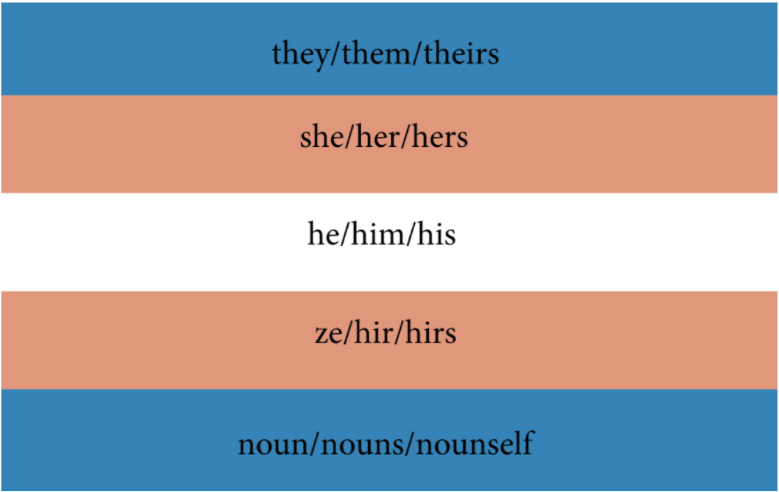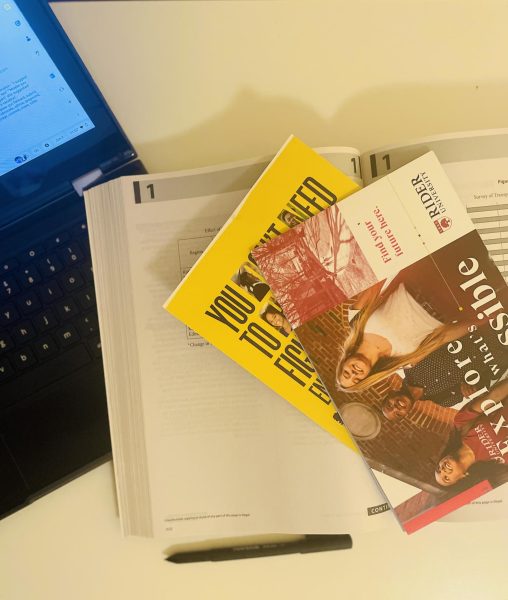Pronouns: What They Are and Why They’re Important
Pronouns Graphic (included: trans flag as background, they/them, she/her, he/him, ze/hirs, and noun/nounself pronouns), created by Ace Moore
November 23, 2021
TW: This article contains mentions of su*cide in the 8th paragraph.
Pronouns. Everyone’s got them. From the wonderful she/her, he/him, it/its, and they/them pronouns, to the beautiful and eccentric neo and xeno pronouns, such as xey/xem, or noun/nounself pronouns, everyone can appreciate everything pronouns do for us in the English language. Lost you already? It’s alright, we’ll go over what these are and how to use them.
For a bit of background, people have been using “non-conventional” pronouns for ages. In Aztec culture, “yehhuātl” was used to encompass all pronouns (including they, she, he, and it). They/them pronouns are also most likely the oldest pronouns in the old English language. In the 1600s, people whose gender was unknown or existed outside the gender binary would be referred to as they/them pronouns in medical records. They/them pronouns became “grammatically incorrect” only in the 18th century.
But as we know now in the 21st century, that is simply not true. We use they/them pronouns in reference to singular people all the time. For example, if someone lost their wallet in a supermarket, you wouldn’t immediately assume whether it is a “he” or a “she.” Most people would say or think, “I wonder who lost their wallet, I should probably return it to them,” using the singular they/them pronouns in a sentence where gender is unknown.
So, using they/them pronouns is pretty simple, though for some it may still be hard. That’s totally understandable! For most people that don’t exist within the gender binary, the best thing an ally can do is at least try. You don’t have to get it right all the time, as long as you are not purposefully misgendering someone.
“[Misgendering] makes me really uncomfortable. I know that the teachers sometimes slip up, I do too sometimes, but when they are continuously misgendering one of my friends or classmates on purpose, it is really unprofessional and makes others—including myself—very uncomfortable,” sophomore Brianna McDonald said.
Junior Allison Tocmo, agreed, saying, “Finding your identity is a really long process, and for some people, it takes a lot of courage to even admit to yourself that you have a different identity than you thought. So if someone misgenders them, it makes all that effort feel invalidated.”
Misgendering is very harmful to anyone, and, as sophomore Barbara Peregrina-Rodriguez said, “It invalidates the feelings of others and makes others feel as if they are ‘wrong’ or ‘not normal,’ which is completely false.”
In a Williams Institute School of Law article, it was stated that “98% of students who had experienced four instances of discrimination and violence in the past year thought about suicide that year.” Discrimination can include hate crimes, purposefully misgendering someone, and bullying.
“It can cause severe dysphoria and negatively affect how the person being misgendered feels about themself,” sophomore Evelyn Calcagni said.
But how can one not misgender a person? It’s quite easy, actually. “Just straight up ask, ‘What are your pronouns?’” Tocmo said. Remember, appearance doesn’t equal gender, so make sure you ask.
Gender is a complicated thing, especially with Xeno and Neogenders. On that topic, how does one use xeno and neopronouns? Simply replace them with pronouns like she, her, they, or them. So, instead of saying ‘He went to the store. He bought eggs and milk for himself and his sibling,’ in the case of someone using zey/zem (xenos) moss/mosses (neos) and xe/hirs (xenos) pronouns, one would say, ‘Zey went to the store. Moss bought eggs and milk for hirself and zer’s sibling.’ All would be referring to the same individual, because a person is never limited to one set of pronouns. Though it might take some practice, it becomes as easy as using they, she, and he pronouns.
Many people in the SCAHS community identify under the non-binary label or have a gender that differs from what was assigned to them at birth. So, when it comes to someone who doesn’t exist within the gender binary, girls and boys bathrooms just don’t work. But State High offers gender-neutral restrooms for those who don’t identify as a girl or a boy. You can find these restrooms in A138, A326, B206, C025, C104, D005, F110, and F111. There are also ones in the ArtSmart hallway, and by the gendered bathrooms outside G pod.
Everybody has pronouns! No matter if you are cis (identifying as the gender you were assigned at birth) or trans (identifying as something other than the gender you were assigned at birth) you have pronouns. So, please respect everyone, no matter what their pronouns are.












